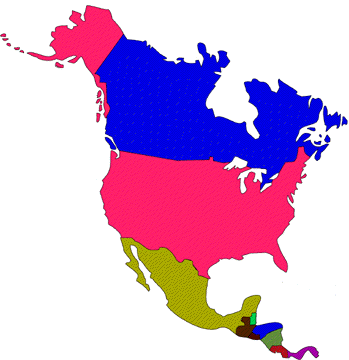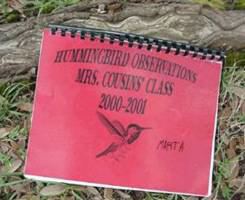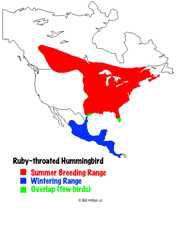HUMMINGBIRD PROJECT DETAILS
Scroll down the page to read the "Project Details" narrative, or click on an individual topic to jump directly to it.
General Information
The GLOBE Program
Timeline
Recruitment of Participants
Scientific Rationale
Sampling of Cross-disciplinary Activities
Funding
Principal Investigator (Bill Hilton Jr.)
-- GENERAL INFORMATION --
Operation RubyThroat: The Hummingbird Project is an international cross-disciplinary education and research initiative of Hilton Pond Center for Piedmont Natural History in York, South Carolina USA.
The project is designed primarily for K-12 teachers and their students from public and private schools in the countries of Central America and North America: the United States, Canada, Mexico, Belize, Costa Rica, El Salvador, Guatemala, Honduras, Nicaragua, and Panama (map below).
 Participation may include home-schooled students as well as folks from informal education venues (e.g., nature centers, camps, scout troops, etc.). Individual students and adults also can be involved (including parents, mentors, and college students). Even though students are the primary target audience, Operation RubyThroat is open to ANYONE interested in hummingbirds! Participation may include home-schooled students as well as folks from informal education venues (e.g., nature centers, camps, scout troops, etc.). Individual students and adults also can be involved (including parents, mentors, and college students). Even though students are the primary target audience, Operation RubyThroat is open to ANYONE interested in hummingbirds!
This unique project uses the Ruby-throated Hummingbird (Archilochus colubris) as a focal point for integrated studies of meteorology, environmental science, animal behavior, botany, and the physical sciences--as well as math, language arts, geography, and other disciplines--all aided by modern telecommunications and computer technology.
Operation RubyThroat provides students across North America and Central America with countless opportunities to engage in meaningful scientific observation and research. The Ruby-throated Hummingbird (RTHU) is a Neotropical migrant; continued disruption of habitat (including rain forests, temperate breeding grounds, and migratory pathways) is likely to have significant negative impact on its populations here and in the tropics. By monitoring RTHUs and learning more about factors that affect them, students develop an understanding of natural systems and how human activity can impact on individual species and habitats.
Operation RubyThroat provides unprecedented opportunity for future scientists to develop a spirit of cooperation that is badly needed if we are to solve problems common to countries of the Western Hemisphere. Data collected and logged into school-based computers during Operation RubyThroat are exchanged freely among participants via the Internet; data also are made available to practicing scientists whose input and guidance are sought during all project phases. There is little doubt that this project will result in publishable papers that, it is hoped, could be co-authored by high school science students and science professionals.
Operation RubyThroat focuses on just one bird species and includes students from a limited number of countries in the Western Hemisphere. As such, it serves as a Pilot Project that, after fine-tuning, can be exported for use by other organizations for students elsewhere who might look at different organisms or phenomena.
Operation RubyThroat incorporates the cross-disciplinary, experiential approach integral to U.S. National Science Education Standards developed under the auspices of the National Research Council and the National Academy of Sciences. The project also embraces many aspects of science education reform that have been called for by task forces, agencies, and blue-ribbon panels in the U.S. and abroad. Components of Operation RubyThroat can be used as ways to teach core curriculum concepts, as enrichment activities, as independent study courses, or as special co-curricular projects for science clubs, Scouts, and other participants.
The Main Goals of Operation RubyThroat are the Eight "E's":
- Enhance K-12 learning in science, particularly conservation & natural history
- Enlighten students about environmental factors that affect hummingbirds (and humans)
- Excite students about field research & potential careers in ecology & related areas
- Emphasize integration of natural science learning into all science disciplines, as well as into math, arts, and humanities
- Establish Schoolyard Hummingbird Habitats to demonstrate the value of small-scale conservation efforts
- Expand student use of technology, especially in the natural sciences
- Encourage international understanding by building student & teacher networks in the Western Hemisphere
- Export an exemplary program that serves as a model for other cross-disciplinary and technology-related projects that focus on new topics (other than hummingbirds)
Back up to list of Project Description topics
-- THE GLOBE PROGRAM --
On 15 March 2002, exciting new animal behavior protocols designed through Operation RubyThroat: The Hummingbird Project became available for worldwide use by schools participating in The GLOBE Program.
Students at GLOBE-certified locations make scientifically valid observations about behavior and ecology of Ruby-throated Hummingbirds (Archilochus colubris) and submit them to the GLOBE Web site via on-line forms.  Students in countries where ruby-throats breed (U.S. and Canada) or overwinter (Mexico and throughout Central America) also submit data about more traditional GLOBE protocols, including atmosphere/climate, hydrology, soils, land cover, and phenology. All this information can then be examined on-line for possible correlations, perhaps allowing students and cooperating scientists to see the impact of environmental factors on hummingbird activities. Students in countries where ruby-throats breed (U.S. and Canada) or overwinter (Mexico and throughout Central America) also submit data about more traditional GLOBE protocols, including atmosphere/climate, hydrology, soils, land cover, and phenology. All this information can then be examined on-line for possible correlations, perhaps allowing students and cooperating scientists to see the impact of environmental factors on hummingbird activities.
Students participating in Operation RubyThroat through GLOBE compile and submit data as part of one or more Ruby-throated Hummingbird "Special Measurements." Details are at "Operation RubyThroat Affiliates with The GLOBE Program."
For more information about The GLOBE Program, visit its Web site at www.globe.gov.
Back up to list of Project Description topics
-- TIMELINE --
Operation RubyThroat was field tested in 2000-2001 by several schools, nature centers, and individuals. During Year One (2001-2002 school year), the project was piloted primarily by teachers and classes recruited from schools in South Carolina, North Carolina, and New York. 
These start-up states were selected primarily because of the principal investigator's extensive school contacts in those three states. By Year Two (2002-2003), recruitment includes schools in the District of Columbia and all 38 U.S. states in which the Ruby-throated Hummingbird occurs. See range maps page for a description of the bird's winter and summer distribution. (Residents of other states may wish to adapt Operation RubyThroat activities for use with hummingbird species found elsewhere.) The project expands internationally in Year Three (2003-2004) to include recruitment from Canada, Mexico, and the Central American countries. Although formal recruitment will follow the pattern described above, teachers and their classes, individual or home-schooled students, nature center personnel, and other adults from any state or country may join the project at any time.
Back up to list of Project Description topics
-- RECRUITMENT OF PARTICIPANTS --
U.S. teacher collaborators and their students are recruited through state departments of education (Science Curriculum Coordinators) and National Science Teachers Association (NSTA) state affiliates; some student participants also are recruited directly through Junior Academies of Science.
High-level contacts in the Organization of American States, the U.S. State Department, and the U.S. Information Agency will be asked to help connect with non-U.S. students. In just its first three years, Operation RubyThroat will have reached tens of thousands of students across North America and Central America. These participants will become involved in ways outlined below and at Project Activities.
NOTE: Participants also can become involved with Operation RubyThroat through this Web site (see How To Participate). The project welcomes involvement by parents and other adults, home-schooled students, and folks in informal education settings such as nature centers and camps.
Back up to list of Project Description topics
-- SCIENTIFIC RATIONALE --
The Ruby-throated Hummingbird (Archilochus colubris) is an ideal species for a cross-disciplinary science study involving students from Canada, Mexico, the United States, and all Central American countries. Ruby-throats--known in Spanish as mansoncito garganta de fuego or chupaflor rubi--are the most widely distributed of all hummingbirds. They come readily to artificial feeders, are tolerant of humans, and--under proper supervision by a licensed bird bander--teachers and students can safely help catch and examine these birds during brief periods of captivity. The Ruby-throated Hummingbird (RTHU) is a fascinating creature that immediately captures a student's imagination and leads him or her into scientific investigation and discovery.
RTHUs are Neotropical migrant insect- and nectar-eaters that breed from Florida to Maine; westward across the Great Plains to foothills of the Rocky Mountains; from south Texas north to southern Canada; and northwest into Alberta. They overwinter rarely in south Florida and on the Gulf Coast, migrating primarily to central Mexico and south to northern Panama (see range maps).  There are a very few winter records from Cuba, Hispaniola, Bahamas, Bermuda, and southeastern coastal areas of the U.S. Little is known about autumn migration routes. Some migrant RTHUs apparently fly from Florida to the Yucatan; however, many RTHUs gather in Louisiana or Texas in mid-September before flying across the Gulf, and some probably take an overland route through Mexico. There are a very few winter records from Cuba, Hispaniola, Bahamas, Bermuda, and southeastern coastal areas of the U.S. Little is known about autumn migration routes. Some migrant RTHUs apparently fly from Florida to the Yucatan; however, many RTHUs gather in Louisiana or Texas in mid-September before flying across the Gulf, and some probably take an overland route through Mexico.
The paths of northerly migration in spring are even less understood; experts speculate that RTHUs follow routes similar to those used when flying south in the fall. In some years, RTHUs appear to move northward at approximately the same rate as the 1.7 degree C isotherm, which may correlate with availability of small insects and flowering times in several temperate plant species that provide energy-rich nectar.
RTHU migration details remain a mystery; no one has ever encountered a RTHU banded in the U.S. anywhere in the tropics, so we do not know specifically where populations from various parts of North America overwinter. Only about a dozen RTHUs banded in the U.S. have been found dead and reported--all from sites within the continental U.S. The first RTHU ever recaptured more than 10 miles away from its banding site was a young male banded and color-marked in September 1991 at Hilton Pond Center for Piedmont Natural History near York, South Carolina, and trapped by another bander 10 days later just east of Atlanta, Georgia.
It is not clear what triggers the onset of RTHU migration, although photoperiod appears to be a major factor. We also do not understand overall effects of local or regional weather; there are no hard data about the actual impact of tropical storms and hurricanes on the trans-Gulf autumn migration of RTHUs, and there is no documentation of the effect of northerly winds on timing and success of spring migration back to the breeding grounds. Likewise, no one has studied extensively the specifics of how RTHU migrational movements may be affected by the cessation of flower production either in the tropics or in North America.
Back up to list of Project Description topics
-- SAMPLING OF CROSS-DISCIPLINARY ACTIVITIES --

Ruby-throated Hummingbirds present a multitude of obvious questions that can be studied by students and teachers in the United States, Canada, Mexico, and Central America. Dozens more original ideas for inquiry will be generated by participants in Operation RubyThroat. Listed below are just a few of the problems that are investigated.
A. Some students monitor and collect Meteorology data, especially during spring and fall migration, to determine possible effects of weather:
-- Plot the tracks and timing of tropical & temperate storms, especially hurricanes
-- Profile of climatological conditions on wintering grounds in the tropics
B. Some students look at Phenology to determine extrinsic factors that may affect timing of hummingbird migration:
-- Chart the dates of first foliage & blossoms on Trumpet Creeper (Campsis radicans), which occurs nearly everywhere RTHUs breed
-- Observe various hummingbird flowers to determine if RTHU visits correlate with time of day
C. Some U.S. and Canadian students (under supervision by authorized personnel) engage in more technical studies in Ornithology, Botany, Plant-Animal Interactions, etc.:
-- Capture & band RTHUs and analyze capture/recapture data
-- Determine frequency of feeder visits
-- Conduct nesting studies, including determination of double- or triple-brooding
-- Determine local abundance and distribution of Trumpet Creeper (and other flowers)
(NOTE: Students on RTHU wintering grounds in the tropics may examine problems similar to those above, particularly with regard to native plant species, etc.)
D. Some students may look at Physics & Applied Engineering:
-- Determine hummingbird flight speeds (using stopwatch and/or video camera)
E. Some students may look at Chemistry & Environmental Science:
-- Evaluate of chemical & caloric content of nectar
-- Conduct field studies to determine if RTHUs forage in areas in which herbicides and pesticides are used
F. All students are involved with Computers, Mathematics & Measurement:
-- Recording & analyzing data; statistics; graphing (computer-based)
-- Networking with other students and professional scientists around the world via the Internet, especially through a listserv devoted to Operation RubyThroat
If you interested in investigating any of these topics, or have other suggestions for projects, refer to the section on How To Participate.
On-line activities for Operation RubyThroat can be accessed from the Projects & Activities page.
Back up to list of Project Description topics
-- FUNDING --
As a private, non-profit scientific and educational site, Hilton Pond Center for Piedmont Natural History must acquire all operating and programmatic expenses from outside sources.
Historically, its activities have been funded in part by grants from the South Carolina Department of Natural Resources, Perky-Pet (manufacturer of hummingbird feeders), Sigma Xi Scientific Research Society of Clemson University, and the South Carolina Junior Academy of Science.
 In Year One (2001-2002), The Christensen Fund of Palo Alto, California USA, became the project's first major underwriter with a gift of $35,000, and The Foundation for the Carolinas Impact Fund followed soon after with a $6,000 contribution. Additional funding has come from National Fish and Wildlife Foundation ($35,000), Phillips Petroleum Company ($35,000), Perky-Pet Corporation ($2,000), and Agilent Technologies ($36,000). The National Science Foundation committed a 42-month grant of $180,000, effective 1 April 2003. In Year One (2001-2002), The Christensen Fund of Palo Alto, California USA, became the project's first major underwriter with a gift of $35,000, and The Foundation for the Carolinas Impact Fund followed soon after with a $6,000 contribution. Additional funding has come from National Fish and Wildlife Foundation ($35,000), Phillips Petroleum Company ($35,000), Perky-Pet Corporation ($2,000), and Agilent Technologies ($36,000). The National Science Foundation committed a 42-month grant of $180,000, effective 1 April 2003.
Because of its potential for meaningful success, it is hoped that other foundations, perhaps in conjunction with state and federal agencies, will underwrite Operation RubyThroat. In addition, Hilton Pond Center for Piedmont Natural History attempts to find in-kind support from other sources, including corporations and individuals. If you would like to help support Operation RubyThroat with a tax-deductible in-kind or financial gift, please go to the section on Funding & Donations.
Back up to list of Project Description topics
-- PRINCIPAL INVESTIGATOR --
Operation RubyThroat is managed by Bill Hilton Jr. (a science educator and consultant, ecologist, and federally-licensed hummingbird bander) through Hilton Pond Center for Piedmont Natural History, a private, non-profit 501(c)(3) research and education facility in York, South Carolina.  Hilton has worked with K-16 teachers and students across the country to improve teaching skills and enhance science learning, using informal education techniques he has designed and perfected during the past three decades. Hilton has worked with K-16 teachers and students across the country to improve teaching skills and enhance science learning, using informal education techniques he has designed and perfected during the past three decades.
In 1982, Hilton began natural history research and informal science education projects at the Center. Since then, he and his students have banded more than 44,000 birds from 123 species at Hilton Pond Center, making it one of the most active sites for ornithological study in the southeastern United States. The numbers include more than 2,800 Ruby-throated Hummingbirds (Archilochus colubris). In addition to general banding, Hilton has conducted and published in-depth research on Ruby-throated Hummingbirds, House Finches (Carpodacus mexicanus), Purple Finches (C. purpureus), and Blue Jays (Cyanocitta cristata).
Hilton has an undergraduate degree in philosophy of science, a master of arts in the teaching of biology, and a master of science in ecology and behavioral biology. He has experience teaching Advanced Placement biology, physical science, and mathematics at secondary and college levels and chaired science departments at two large high schools. He served twice as president of the South Carolina Association of Biology Teachers and in 1988 helped begin and taught biology and research techniques at the South Carolina Governor's School for Science and Mathematics. On three different occasions he was named South Carolina's "Science Teacher of the Year" for his innovative classroom techniques and professional leadership.
In 1987 Hilton received a grant from the South Carolina Department of Education to write, publish, and disseminate nationally a major enrichment unit on "Bird Banding: Experiencing the Scientific Method." He lectures across the country about science education or nature and is author of The Piedmont Naturalist. His natural history writings appears both in popular magazines and technical journals. Hilton has broad experience with telecommunications, multimedia, and the Internet and has extensive personal and professional contacts in science, technology, education, and business--some of whom will be called upon to provide support and assistance for Operation RubyThroat. Hilton travels the country lecturing about science education, hummingbird research, and natural history topics and is available to address groups of any size.
Hilton is guided in his work as Principal Investigator for Operation RubyThroat by a national Board of Trustees and a prestigious Advisory Council. Dr. James C. Shuman and Dr. Mark W. Miller are co-principal investigators for GLOBE-related aspects of the project.
Back up to list of Project Description topics
|

